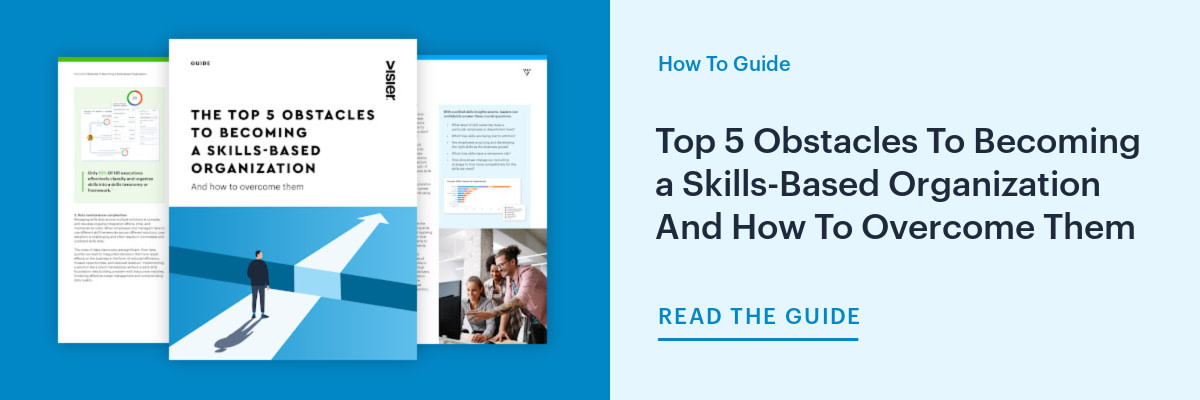Talent Development: What Is It, Benefits, and How To Improve It
Employees and organizations thrive when everyone is empowered to grow. Talent development is at the heart of that growth. Learn more here.

The current business landscape is more competitive than ever. One key to thriving is focusing on your number one asset—your employees. The best way to do it? Talent development. This is a simple, yet effective strategy that allows you to develop your employees’ skills in perfect alignment with your business objectives. Here’s everything you need to know about it.
What is talent development?
Talent development is a method of strategically developing your employees’ abilities and skills in a way that aligns with the company's strategic priorities, helping them reach their full potential. It focuses on employees’ existing skills, but it also helps your new skills and opportunities for each person and the company.
Talent development is a great tool for internal mobility, reskilling, and upskilling. It can take many forms, such as
mentorship
coaching
formal training
on-the-job learning
Developing talent often goes hand in hand with other learning and development programs in the company. In most cases, L&D has a broader scope, looking at the entire organization. In contrast, talent development programs are created with each person, and each skill in mind, and seek to align both to the company’s goals.
Talent development in HR: The difference between talent management and talent development
Talent management and development may sound similar, but their scope is rather different.
Unlike talent development, which focuses solely on existing employees, their skills, and their potential, talent management takes a broader look at the workforce and includes:
The onboarding process
Talent development has nothing to do with attracting top talent or onboarding new employees. And while it can be a great tool for retention, that’s not always the primary goal behind it. Instead, its aim is to help employees grow and improve their existing skills, learn new ones, align their development goals with those of the company, and become better at what they do.
Talent development often contains an individualized learning and development strategy. Talent management, on the other hand, takes a broader approach, focusing on the organization’s strategy of hiring, onboarding, and retaining top talent.

Why you need to prioritize talent development
Your workforce is an incredible source of talent. And if we’re honest, it can make the difference between reaching your goals or failing. Helping employees become their best, improving their skills, and learning new ones is crucial.
In a study conducted in 2020, the World Economic Forum predicted that 50% of the global workforce will need to learn new skills by 2025. We can’t say for sure if their prediction will come true. But we know more and more people want to learn new skills at the moment.
Plus, with the constant shifting of the business environment, you need to prepare your workforce for the future of work. Instead of watching your skill gaps become bigger and bigger, invest in talent development to ensure your employees are ready to face new challenges.
4 benefits of talent development
Talent development helps your employees become better. But its benefits don’t stop there. Here are four ways in which talent development can support your company.
1. Improved productivity and performance
There are a lot of things that motivate employees to do better. One of them is the constant opportunity to improve their skills and learn new things. When you make talent development a priority, you’re telling your employees you see them, their talents, and their results. Plus, you’re giving them the tools they need to surpass challenges and be the best they can be.
2. Improved engagement
Disengaged employees don’t perform their best and they are usually the first to leave the company when an opportunity presents itself. When you focus on each person’s skills and aptitudes, people become more engaged and feel better about their job and the company.
3. Reduced skills gaps
Skill gap reduction is not a primary goal for talent development, but it is often one of its byproducts. That’s because it encourages employees not only to improve their existing skills but also to learn new ones.
4. Increased retention
The days when people earned a degree, learned a few skills, got a job, and then spent their lives using just those skills are long gone. In today’s business environment, such a scenario would not only be impractical, but it would set you up for failure.
Employees want to work with companies that offer them learning opportunities. And a talent development program will give them all that and more, making them less likely to leave at the first opportunity.
7 steps to improve talent development at your organization
Given its numerous benefits, it’s natural many companies want to create a talent development program or improve the existing one. But for your program to be successful, you need to start with a clear plan in mind. Here are seven steps to help you on your journey.
1. Assess the company objectives
Talent development programs take an individual approach rather than a general one. But that doesn’t mean you shouldn’t align them with your business goals. To start, assess where you are from an internals skills and knowledge standpoint, and outline where you want to get to as an organization.
Say you want to introduce new technologies. Do you have anyone with the right skills to use it? What about adjacent skills? What will help them reach proficiency with ease?
2. Assess all the existing skills
Once you know your objectives, it’s time to look at the skills you have within the organization. Look beyond job descriptions. Often, employees can do so much more than the job requires.
This step will help you quickly assess who the best candidates for upskilling or reskilling are. It will also show you what skills gaps exist, where you need to focus your efforts, which candidates are already using a lot of their skills, and which ones have amazing but unutilized aptitudes.

3. Choose a variety of learning methods
Once you’ve identified the skills you need to develop, and the best candidates to learn those new abilities, the next step is to facilitate learning and development. When doing so, try to provide a strong cross-section of learning and development activities. You may feel like a live workshop is the best way to help someone learn. But what if some people prefer to learn in their own rhythm, by reading and then trying each new thing?
The best method for one employee could be a complete disaster for another. Try to offer several learning options to accommodate each style and preference.
4. Create a culture that encourages learning
Most employees want to learn new things. But at the same time, if your company’s culture doesn’t encourage continuous learning, your talent development program might not take off as smoothly as you’d hoped.
Communicate with your employees and make sure they understand that learning is a core value. Support them in attending conferences, workshops, and even pursuing new certifications. Lead by example and encourage managers and senior leaders to share their learning paths and organize department-wide L&D sessions.
5. Prioritize diversity and inclusion
When you say “talent development”, DEIB might not be the first thing that comes to mind. That is a mistake that can derail your entire program.
Take action to ensure everyone has equal chances to learn new skills, grow, and improve. Make transparency and equity a priority. Otherwise, many will be left behind, which will hinder your efforts of creating a successful talent development program.
Assess your current practices when selecting employees for reskilling or upskilling, for instance, and make sure your learning programs are accessible to everyone.
6. Include all stakeholders
The HR department is primarily responsible for talent development, but it shouldn’t be the department involved. Everyone in the organization should participate in some capacity—from human resources, managers, team leaders, and the employees themselves.
This will increase transparency and inclusion and will ensure the program you create addresses pain points and skill gaps, while also aligning with the company’s goals.
7. Monitor and review
Talent development is an area that will need constant monitoring and improvement. Skills come and go, employees move both internally and externally, and technologies are changing from one day to the next. Plus, your company may also adjust its goals and expectations.
Keep an eye on various HR metrics, including productivity, performance, engagement, or attrition, to understand how successful the program is. Don’t forget to ask for feedback from employees to understand how they feel about the program and if there are any improvements you can make.
Talent development is a powerful strategy that allows organizations to enhance their workforce’s skills and capabilities. By focusing on individual growth, talent development programs can boost engagement, productivity, retention, and more. A structured plan, that takes into consideration the company’s goals, and fosters a learning culture will help you harness its benefits at all times.
On the Outsmart blog, we write about workforce-related topics like what makes a good manager, how to reduce employee turnover, and reskilling employees. We also report on trending topics like ESG and EU CSRD requirements and preparing for a recession, and advise on HR best practices like how to create a strategic compensation strategy, metrics every CHRO should track, and connecting people data to business data. But if you really want to know the bread and butter of Visier, read our post about the benefits of people analytics.

Get Outsmart content straight to your inbox
Subscribe to the People Insights Monthly newsletter for actionable insights and stories.
Subscribe now